

Classic Buses Profiles
Clifford Jones's scrapbook (memories of a Southdown man) - part one (by Dick Gilbert)
Page last updated on 24th September 2020
SOME LINKS WITHIN THIS WEBSITE: Home Email Links THE COMPLETE WEBSITE MENU Events Diary Halfcab list Small-Ads Classic Irish Buses Classic Manx Buses
This page is a collection of memories and pictures from the fascinating bus career of Clifford Jones. It started with the preservation of a Southdown single decker and then a breakdown tender, continues with a bit of buying and selling, and later turns into a career managing and driving buses and coaches.
Here is the story of Clifford's life among the buses. All photos were supplied by Clifford unless otherwise credited.
To Clifford Jones's Scrapbook - Part Two

Oh my word! What an opener - just look at this lot. Here we see Bognor Regis Coach Park in the 1950s, as Clifford Jones would have seen it on a typical summer weekend. The photo is reproduced by kind permission of Hazel Bell, wife of Southdown conductor Colin Bell (see more details about Colin below) who took the picture. Colin's father Leonard Bell was superintendent of Bognor Coach Park.
This story starts in Bognor. When Clifford Jones was seven or eight years old he would travel home from school on local Southdown buses from Aldwick into Bognor town centre. One character he remembers is Colin Bell, who worked as a seasonal bus conductor in 1954.

Southdown conductor Colin Bell on 1946 Leyland PD1 Titan No.290 (GUF 690). It was allocated to Bognor depot at the end of 1953 and scrapped in 1959. Photo with thanks to Hazel Bell.
Colin's wife Hazel says: "The picture of him as a bus conductor has a very special meaning for me, as that's how I met him! It was the time between my leaving school and starting at university, and I took a holiday job as waitress at Elmer Sands Sussex Club. I caught Colin's bus to work quite often, and that's how we met. We married and reached our Golden Wedding before he died. And I so well remember the beautiful bus station in Bognor, now long gone, scandalously! He worked as a bus conductor again in 1955 as a holiday job from Oxford University, while I was selling ice cream on Bognor prom as my holiday job (from Reading)".
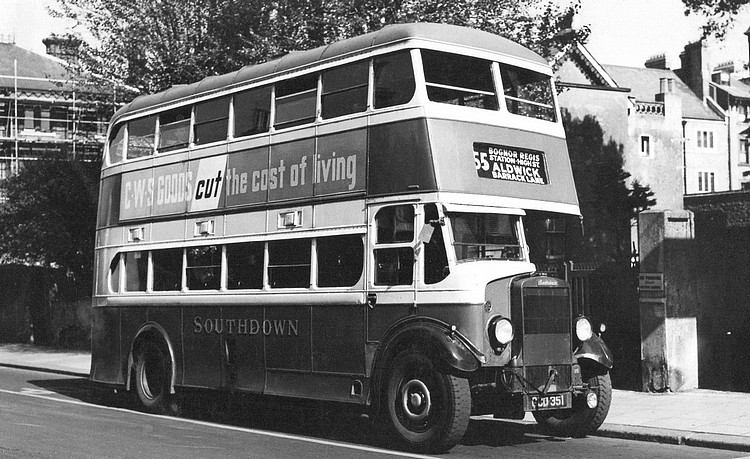
Southdown Leyland Titan TD5 no. 251 on route 55 in Bognor. I believe this photo to be taken in the late 1940s with its original 1939 Park Royal body, which was replaced with a new one in 1950. Photo from the Clifford Jones collection.
Clifford says: "I was born in Bognor Regis and this picture was the view I would see when looking out the window of the flat where my parents lived. This got me hooked on Southdown buses, as they stopped opposite the room (lounge) where I was born, so I saw this view regularly. The garden behind the bus belonged to a doctor who lived in a large house in the grounds".
"TD3s and TD5s were regulars on the local services 50, 50A, 55 as shown here, and the 57 to Chichester via Fontwell as well. 51 and 55 were usually serviced by single decker 1400s but double deckers were used in summer loadings. The long distance routes 31, 60 and 69 were operated by the PD1s, though the 69 had a TD5 on it occasionally - although Bury Hill proved to be a plodder when I drove GCD 48 on a recreation on that route. She nearly died on me at the first bend of a 1:6 hill with a full load so I hit first gear and she growled up the hill, as the conductor was able to jump off the platform and walk alongside by the cab. I just couldn't believe it as the Guy had flown by with his Gardner engine."
"When I was 13 or 14 we moved to a private estate at Aldwick with palm trees. Lowbridge TD3s generally had to be used in the summer as the trees were very low in Barrack Lane and bashed the bus quite hard. Funnily enough both my parents acquired company cars so I adopted the family car which was a 1954 Hillman Minx and at the end of the 55 bus route was a parade of shops including a petrol station where I would buy a gallon of petrol for 4/11d. Craigwell Estate was a stone's throw away, where King George stayed with the famous saying bugger Bognor!"
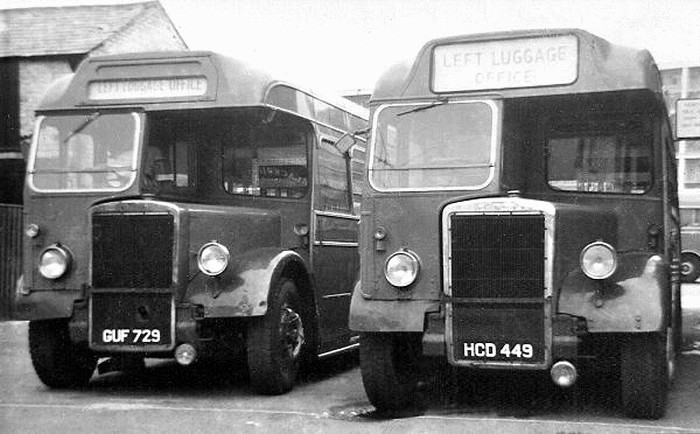
Bognor left luggage buses, both 1947 Leyland PS1 Tigers.
Clifford recalls: "My first bus was an ECW-bodied Leyland Tiger PS1 (HCD 449) which was delivered in 1947 as a coach, converted in 1954 to a bus, and finally to a left luggage office at Bognor Regis. I was about ten to twelve years old when I first noticed two buses in Bognor's rear yard, before the new development that allowed buses to enter and exit from the rear of the old flint stone-walled yard, and the garage was opposite the railway station. They hardly ever moved, except in the summer to take their position the other way around, to take on luggage left by inbound holiday-makers arriving by coach before they could go to their B and Bs which had strict rules about the time of arrival."
"I got to know Bob Mustchin the garage foreman in those years, as I was a latchkey kid and took to wandering around the bus station watching the buses coming in the right-hand side entrance at the front. They would go around the waiting room then reverse up into the rear bays either side of the rear sliding doors. Those were no. 31 route in both directions and the longest stage carriage route in the UK. They included the 69 route to Horsham, 57 to Chichester via Eastergate, where Southdown still had a dormitory garage which had reverted to a store and one of these left luggage offices, D689 (HCD 449) would go up to deliver and collect stores."
"Finally there was the 65 route to Slindon via Barnham. Local routes 50 and 50A, which ran across Bognor from Pagham to Middleton, went around the waiting room in both directions. This left the local 51 and 55 service which stopped outside, and an odd route 60, which started and terminated at the railway station going to Midhurst via Chichester. We must not forget an intrusion in the summer only of Aldershot and District service 19 from Aldershot via Haslemere, Midhurst and Chichester to Bognor. Coaches included the London ones and the South Coast Express which ran the full length of the coast from Margate to Bournemouth and beyond. The sight of the Royal Blue coach arriving with the driver, who sported white gloves, was fascinating and of course the coach gleamed."
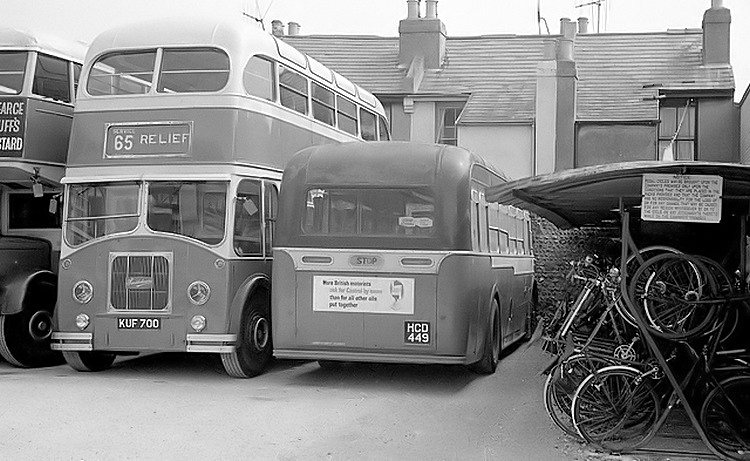
Southdown's unique Leyland PD2 coach no. 700 and Tiger D689 at Bognor.
As well as Tiger D689 in the above photo is the famous one and only Southdown mistake - Fleet no. 700 (KUF 700), built for Southdown as a prototype to relieve the heavy loading on the London to Eastbourne coach route. Fitted with coach seats, passengers complained that it made them feel travel sick as the vehicle rolled so much because of its weight causing it to be under-powered.
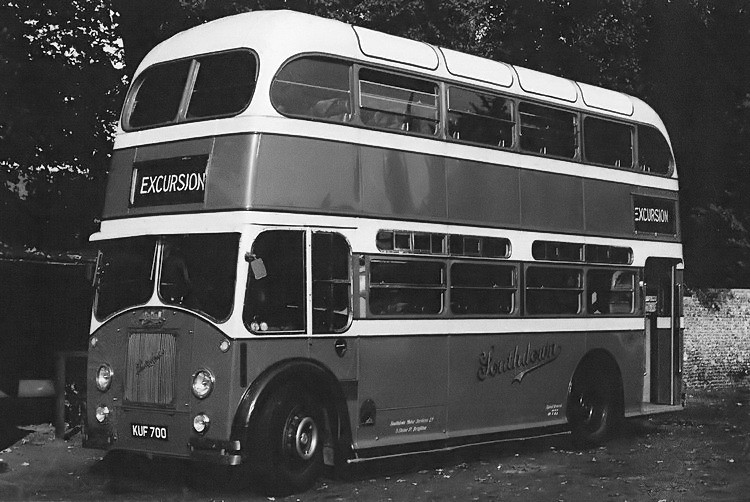
Southdown's unique Leyland PD2 coach no. 700 at Bognor.
The picture above isn't great, but shows no. 700 exactly as I remember the bus, showing it in solitary against the original yard flint wall just before the retail development engulfed it. Finally management decided to turn it into a breakdown tender but, after work started to cut the body down, it languished in Portslade works as a forgotten hero until it was scrapped.
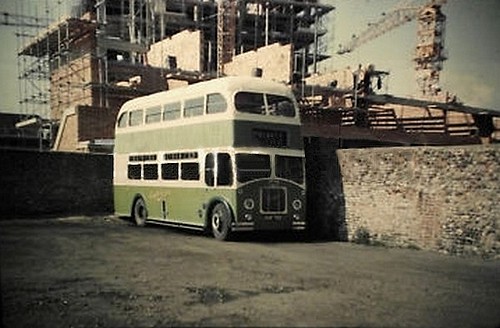
Another view of Leyland PD2 coach No.700 at Bognor. Photo from the Bob Gray collection.
This photo, kindly supplied by Bob Gray, shows 700 at Bognor in a different position from normal, possibly involved with its normal roles of excursion or relief work.
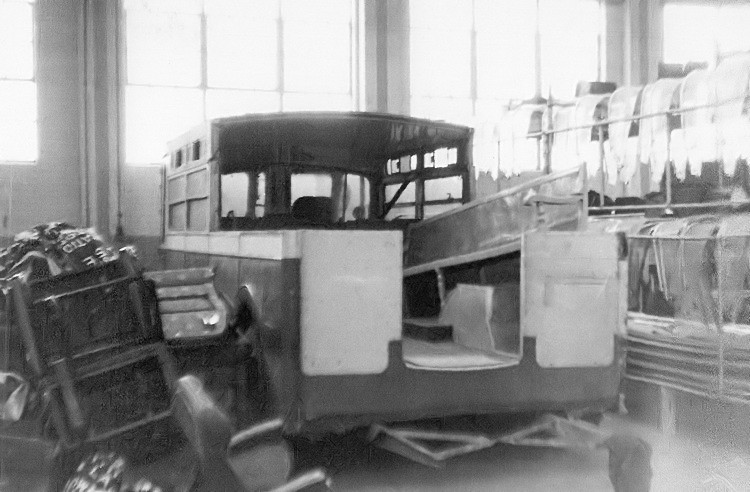
Southdown's no. 700 as an uncompleted breakdown wagon at Portslade. Photo from the Bob Gray collection.
700 languished hidden away in a corner at Bognor Regis for years, relegated to excursion work and occasional service bus relief. However on a visit to see Bob Gray in 2015, he very kindly gave me the above photo, which I had never seen. It shows 700 cut down to become a breakdown tender which was never completed. Southdown Engineering Ltd., who took over Portslade when the depot was sold, scrapped it!
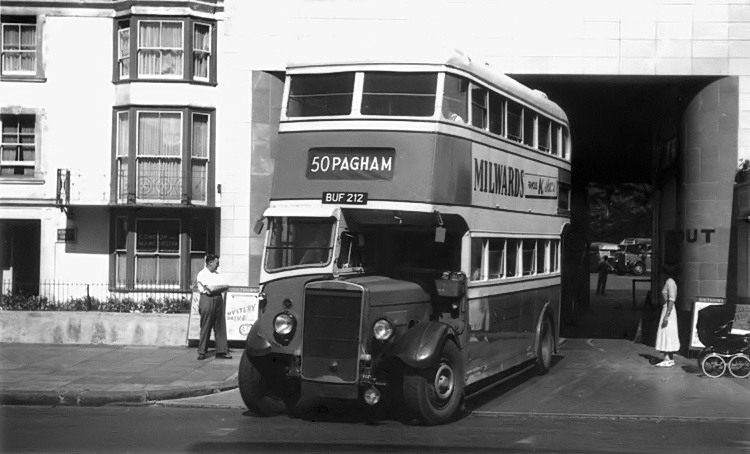
Southdown 112 (BUF 212) at Bognor, a 1935 Leyland TD4 Titan rebodied in 1947.
"My life moved on and by the time I was fifteen or sixteen other interests prevailed, which I shared with a school friend, including railways which led to a lot of steam train travelling in my school holidays. During the 1950s and 1960s excursions arrived at Bognor most Saturdays and it was fascinating to watch the shunting as Bognor had only one platform with a loco release. The stock was dumped everywhere including stations nearby. I still popped in to see Bob Mustchin, but retail development changed the yard at the back after a garage exchange with Hall and Co. and the adjacent retail nudged up to the 1930s style bus station, demolishing my mother's favourite restaurant."
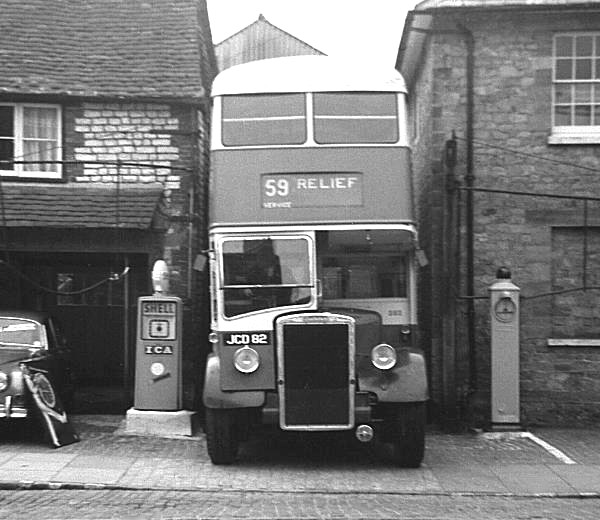
Southdown all-Leyland Titan PD1 no. 382 (JCD 82) at Midhurst garage in 1966.
"Seen in the photo above is Southdown JCD 82. I'm virtually certain that I used to get on this bus at Rose Green in Bognor when I went to Chichester College of further education on the day it first opened in September 1964, having left boarding school in the Cotswolds. It was an unusual relief as it started at Felpham on the other side of Bognor as a 60 relief and ran the 50 route into Bognor, but changed to 31 route on entering Bognor. That meant it was the only bus that turned right up Sudley Road to get to the Railway Station to start the 60 route to Midhurst, on the basis that it was at peak school time there were three reliefs plus the service bus!"
"It rounded the corner at the bottom of the road where I had digs, as my parents worked in London and lived during week at a flat in Surbiton, overtook the service and I was the next stop. I put my hand out for the first time and the driver only just slowed down enough for me to jump on the platform which happened every time I went to college. We went like a bat out of hell then non-stop to Chichester Bus Station and later in my life I found the driver who looked like Jimmy Edwards was in a snooker school and had to get there quickly to get a maximum break for his snooker game. In severe snow one day the bus hit low overhead wires weighed down by ice and the driver backed up with the help of the conductor and went the short route, which meant retracing his steps and turning left."
"The girls from Chichester Grammar School always used to save me a seat and, you guessed it, I was smitten. It was strange as we all went home on the train! I had a dilemma if I waited for an electric (third rail) train to Brighton from Chichester, as I missed the steam train at 1605, which was usually a Bullied Pacific but occasionally a Schools class."
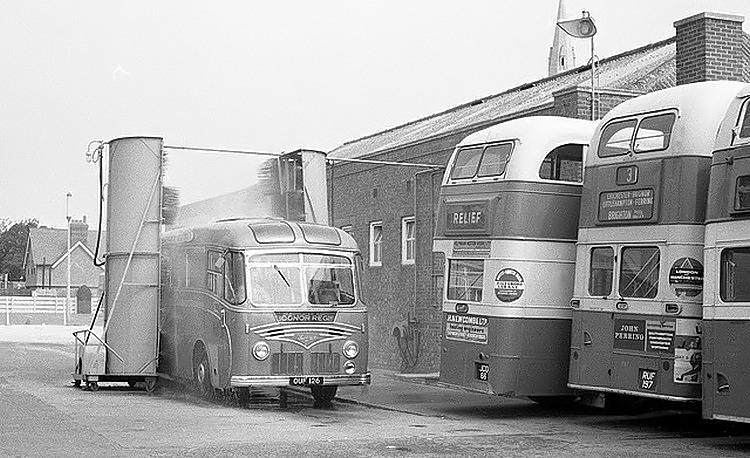
1026 (OUF 126), a 1955 Tiger Cub, goes through the washer at Bognor.
"My life gathered apace when, in my early 20s, I caught up with Bob at Bognor and noticed the sorry state of those left luggage cars, as Southdown always called buses - which is short for carriages, developed by the founders as far back as 1915. Bob said they would be sold for scrap and, before I could think the better of it, I arranged for me to buy D689, which he suggested was the best mechanically."
"Delivery was arranged to my workplace at Dorking to park it behind the factory. I waited down by the A24 with my wife in our car where it passed the railway station and was relieved to see 0825, the Chichester AEC Matador, coming over the crest of the hill up the A24 with her orange light flashing and my purchase hanging on the end of a rigid tow bar."

AEC Matador 0825 at Chichester in NBC livery in the 1980s.
"I quickly guided them up to Dorking Town station yard where they dropped off their charge, wished me luck, assuring me that she started on the button. This was the first time I had climbed into the cab of a bus to drive it! Fortunately boarding school gave me the chance to drive tractors and the local farmers' cattle trucks, so it was not unfamiliar. Yes, she started on the button and 15 minutes later she was maneouvered into a space after being reversed around two sharp bends."
"The only thing I could not work out was why the engine kept stopping when I let it tick over, with that fabulous Leyland whistle. Later investigation revealed that the slow-running adjustment screw had been removed as the stop cable was seized, which was my first bus repair. My first bus remained in Dorking for a few years now while I looked after my family and my career gathered apace."
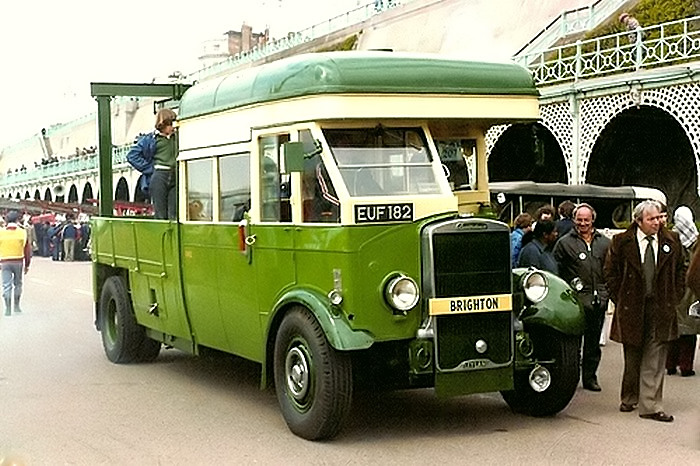
0182 on a London to Brighton run when owned by Peter Burton.
The next instalment was moving house to Farnham and driving D689 to a new parking place in Wrecclesham. A friendly local recovery company owner sat in the back while I used his trade plates to get it there. I met Peter Burton who lived a few doors down from me and who had purchased an ex Southdown breakdown tender, 0182, built from a 1938 Leyland Titan TD5. It was based at Hilsea and had been bought by the famous David Fereday-Glen. Peter asked me to help him change the diff on the rear axle as it was a high-ratio version for towing. This friendship led to the forming of the West Surrey preservation group with Norman Hamshire and Gerry Bixley who later owned 1939 Southdown Leyland TD5 Titan No.248 (GCD 48).
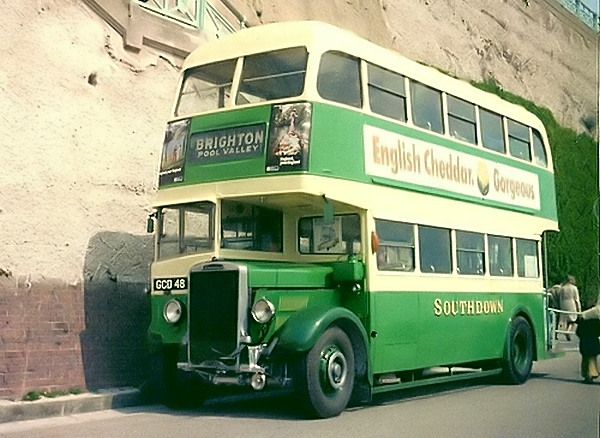
Southdown 1934 Leyland TD5 no. 248 (GCD 48) at Brighton.
This is the first time I saw 248 (GCD 48) - it was owned by Doug Allan from Ross on Wye. Notice the silvering under the engine; we told him about this, as it should have been dark green except inside the chassis frames. We could not raise the money to buy it, so Cobham Bus Museum bought it for crash box training.
I got on with Alan Allmey, the Cobham caretaker/manager who was tragically killed in a road accident with his wife, and I was later able to persuade him to sell 248 to me at a very low price, on behalf of Gerry Bixley who put up the money. I delivered it to Gerry. Since then it has changed hands a couple of times and I saw it at a recent Southsea Spectacular.
David Fereday-Glen was in partnership with a man called Brian, an estate agent in Guildford who was the backer for David to buy and sell classic buses. They had won a bid with Southdown for 0181 and 0182 (both being breakdown tenders converted from 1938 Leyland Titan TD5s), so David used 0182 to tow 0181 to a pub car park at Milford from Portslade - or wherever they were stored prior to disposal - just off the A3 at Godalming. Peter Burton had expressed an interest and bought 0182, leaving 0181 on its own for a short while.
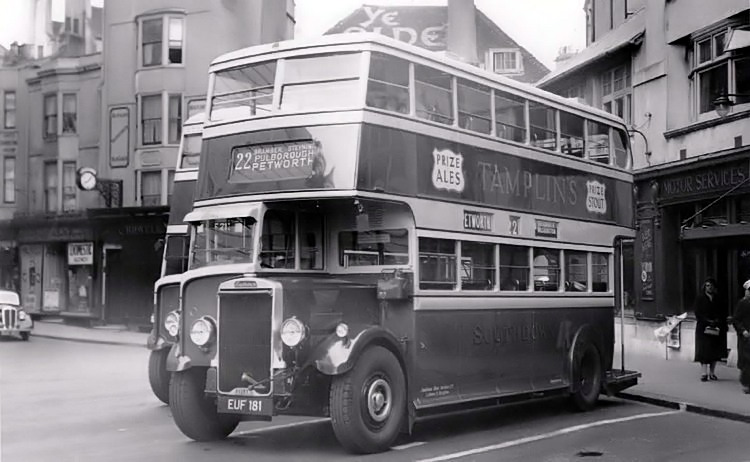
This is Southdown Leyland Titan TD5 no. 181 (EUF 181) with a Beadle lowbridge body at Pool Valley, Brighton, probably when virtually new in 1938. Retired after 18 years service, the chassis was used to create breakdown vehicle 0181, using trade plates 184 CD and the body transferred from UF 5425, an even older breakdown tender. Clifford was later to become owner of 0181 for many years. Photo from the Clifford Jones collection.
"I was contacted by Brian saying that 0181 was at May's Motors in Elstead and the engine had been rebuilt with a bill of £500 that he couldn't pay, let alone have it reinstalled. I sold the engine for £350 and made up the difference temporarily. I had bought an ex Southdown a PD2/12 - 794 (RUF 194) Leyland PD2/12 / East Lancs H33/26RD - which had been withdrawn in 8/69 and sold to Frank Cowley (dealer) at Salford, but may not have gone there. It was sold direct to Adur Metals in 11/69, a factory at Shoreham who used it as a non-PSV for staff transport. I bought it in March 1977 after a test run, then sold it on so I delivered it to an owner of a fishing lake at Camberley with the proviso that I took the engine out - which I did by the side of his lake with the engine lift from Blue Saloon Buses at Guildford, transported with 0182. My father had a heart attack at Bognor Regis while I was doing it and my wife came to collect me, so I went to Chichester hospital in my overalls! The engine was sold to Cobham Bus Museum for a London Transport RTL and I bought a TS7/8 engine from Dave Hoare at Winkleigh with the proceeds, after going down there with Peter to start it up and run it for 30 seconds with 2 sets of welding m/c cables and jump leads."
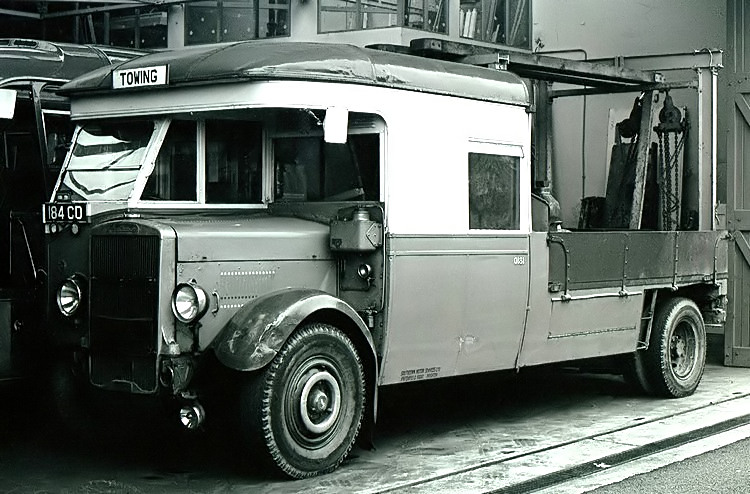
0181 at Freshfield Road garage, Brighton.
"Stagecoach has identified the above picture as being at Freshfield Road garage in Brighton. It is a very early photograph because there are no flashing indicators (pear drop), flashing amber beacon, and a split windscreen, which was a single piece of glass when I acquired the vehicle. We removed the swan neck shaped support between the two chain hoists we removed and used it for a tow bar."
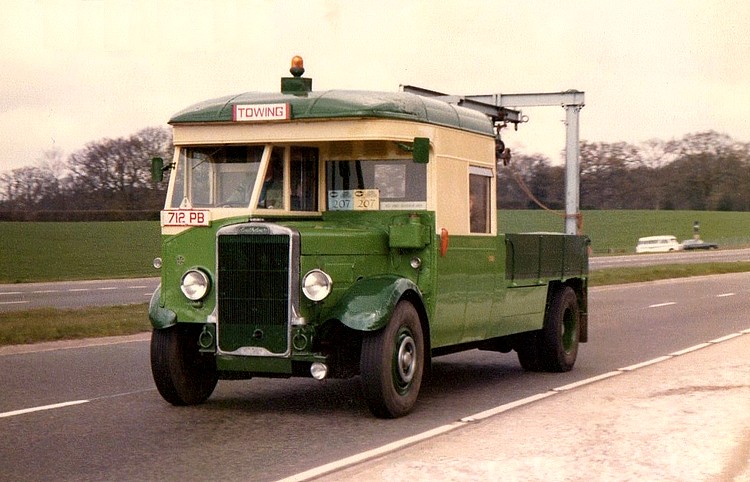
Clifford's breakdown tender 0181 on the London-Brighton run.
"A fourth member of the Group, Maurice Pertheun, eventually purchased from Norman Hamshere an ex Western National 1940 high-radiator Bristol L5G (DOD 518) that ended its working years as a staff refreshment bus, and Norman had restored the body. Norman sold it as he was hankering after a small Aldershot and District Dennis Falcon which was easier for him to eventually drive, as a car was not easy for him. His skills came from working at Dennis's for years building etc. He eventually compromised with an East Kent Falcon, as I drove it to rallies for him."
"We towed DOD 518 back from Swindon around 1987. Peter Burton and I had just got to know each other as we both lived at Wrecclesham on the outskirts of Farnham. 0182 had its diff sorted out with old telephone directory covers for gaskets, so it gave a few more mph but the rear wheels, if I remember rightly, were still 750s and needed to go to 900 tyres for the same reason. So the embryo of the West Surrey Preservation Group set off in 0182 with Peter, Norman Hamshire and I plus a couple of others that Norman had met at the Cobham Bus Museum."
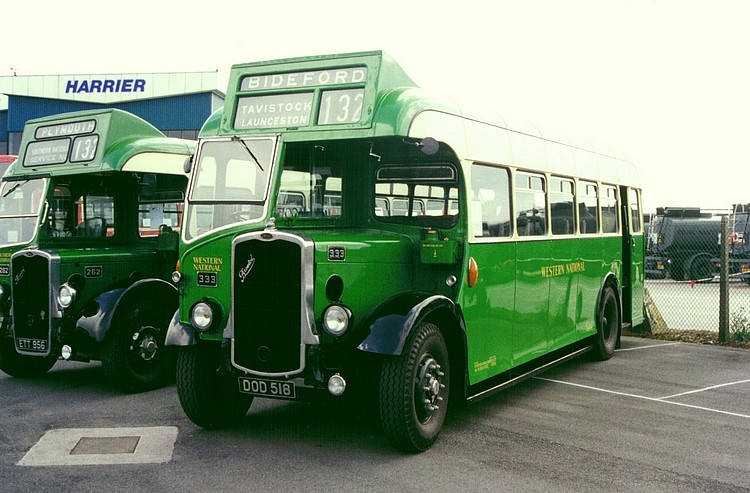
Western National Bristol L5G DOD 518 at the H. C. V. S. Rally, Yeovilton in 1995. (photo: Dick Gilbert)
"This was our first tow but we had the axle clamp and rigid bar set up with a tail-light bar on the
back of DOD 518 and Norman had set up a telephone link between the two drivers - it was two wooden boxes (ex BT) with a load of
wiring in them, plus a telephone exchange headset so we could talk to each other, especially when all brakes had to be applied. In
fact it was the assistance of DOD's handbrake that became the norm for the future, as the Southdown vacuum-assisted hydraulic brakes
left a lot to be desired and that was the primary reason Southdown retired them.
"I seem to remember that we picked up DOD 518 around the back of Swindon station in the old redundant station buildings. Our journey set off okay. Nobody seemed to want to steer DOD 518 so I got in the cab and off we went through the town, until we came to the infamous Swindon multi-roundabout junction. I had drawn the short straw to steer DOD 518 and all I heard over the wire from Peter was which way am I supposed to go across this lot?, as every exit and entrance had a separate white- painted roundabout leading to the central one. In the end he took the shortest route and we ended up on the M4 plodding along at 30 m. p. h."
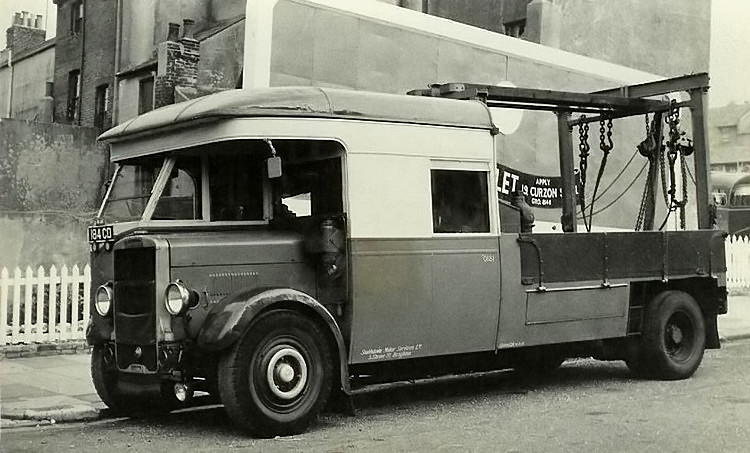
0181 outside an unknown Southdown depot.
"We came off at Newbury and headed for Basingstoke and then through to Guildford where we encountered the worst bit of Mini driving around the one-way system I've ever experienced. A Mini screamed up the outside of me as we had positioned ourselves on the left of the road to take the sharp right just above the bus station. The driver of the Mini realised that 0182 was turning right so he tried to cut in between us and encountered a tow bar! I shouted down the phone system "STOP!" and we did. The Mini swerved back to the right and shot off like a scalded cat."
"Reaching Ewhurst which, I would add, featured a dormitory shed for Aldershot and District in the grounds of Norman's family home, but we had to back DOD 518 through a builder's yard because the track down to the shed was 7ft wide and DOD 518 was 7ft 6ins wide. This manoeuvre meant 0182 pushing DOD 518 diagonally across the yard over a slight hump and onto the track at 30 degrees. Then we continued backing down a grassy slope into an old chicken shed. It took us amateurs about two hours to complete, but we got it in by the time the light failed. Strangely enough when the bodywork had undergone some cosmetic finishing off, DOD 518 drove herself up to the road and backed into the dormitory shed which had been disused by Aldershot and District for some years and returned to Norman's family."
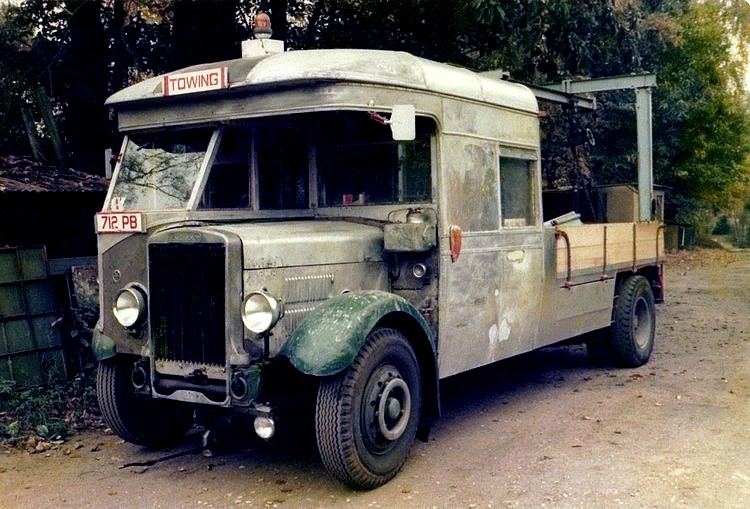
0181 under restoration.
"The sale of DOD 518 to Maurice Pertheun created another West Surrey bus for rallies, but the fuel autovac gave up a couple of times and ruined Maurice's confidence to go any distance. In later years we disbanded and Maurice moved to St. Austell, so I was asked to drive DOD 518 down there because the autovac still had a habit of running out of fuel and Maurice didn't want to take the chance. It's amazing how far you can get on 1 1/2 gallons at a time from a can, but I didn't need to do it. All you have to do is listen out for the little puff it makes when getting rid of excess vacuum.
"0181 was later stored at Southdown's Horsham garage by arrangement with Southdown senior management who proved to be very helpful in later years, but before that DOD 518 was stored there first, so after work I drove down there and started DOD 518 up. While I was checking her, Bill the foreman said ...and where are you off to then? St Austell, I said. He was sure I was mad to be going all that way on my own and left me to it."
"After a brief stop in a layby at Exeter for a cup of coffee and a sandwich in one of those infamous wayside caravan snack places, I arrived in St Austell at 2am in the morning. I gave up trying to find the delivery address where it was going after an hour of driving down narrow country lanes, and phoned the owner with my brick mobile phone! His reaction was classic. The story ends with a lift to Plymouth coach station the next morning with my Trathens uniform on, to catch the London coach they operated, with my overnight bag and a toolbox."
"I occasionally persuaded Peter Burton to take on some tows with 0182, much to his disgust, but it has a feature in my story. He phoned me and said that he had been in touch with the owner of EUF 196, a 1938 Beadle-bodied Southdown Leyland Titan TD5, and we were going up to see it at an airfield in Norfolk with a view to buying it. I assumed we would be driving up. Oh no, he said we are flying!. The owners used the bus for a club base at an airfield where they did gliding etc. So we flew up there in this sort of Chipmunk from a local aerodrome near Basingstoke with some batteries and jump leads etc. It transpired that it ran, but was not driveable on such a long journey to Surrey. We agreed that since 0182 was on the Trans-Pennine run in the next few weeks, all we had to do was turn left on the way home."
"This we did and after a restless night we set off with the tow at the early dawn, down the A11 and in those days it was onto the North Circular for home. Somewhere near Newmarket we stopped for some reason - probably a brew - and Peter jumped out of the cab of 0182 and twisted his ankle very badly. He was in considerable pain. There was no alternative than to swap places and off we went. In reality he nearly passed out a couple of times but we pressed on around the North Circular and she gave me doubts when we pulled up at the traffic lights at Hanger Lane as to whether she would pull away. My doubts were put to one side as she eased away from the lights with a growl, having 12-13 tons on the bar."
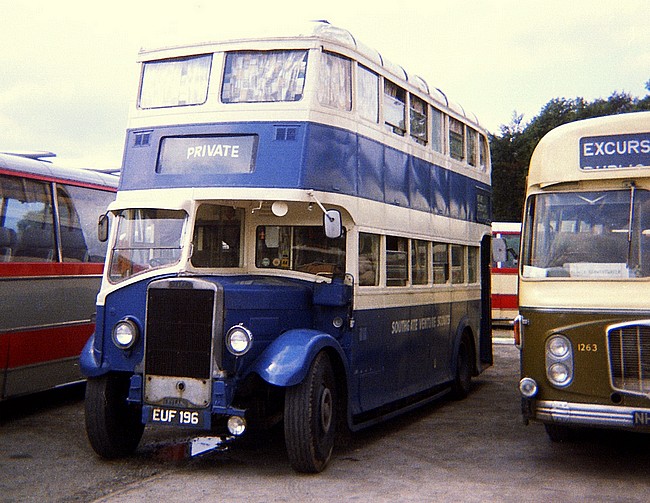
Southdown Leyland TD5 no. 196 with 11th Southgate Venture scouts group, probably in the late 1960s. Photo with thanks to CWG43 on Flickr, via Clifford Jones.
"No. 196 (EUF 196) was sold by Southdown to Hutfields Coaches of Gosport in 1956 and it remained with them for ten years. The above photo shows it in the colours of 11th Southgate Venture scouts, who bought it via a dealer in 1966, and used it until the early 1970s. The upper deck was fitted with bunks and the lower deck used as living quarters for an expedition from London to Istanbul. The West Surrey Preservation Group acquired it at the end of 1975."
"I believe the photo shows it before it became a static hut at the airfield we went to and towed it back to Farnham. I note in the photo that it has modern commercial rear view mirrors and not the standard bus ones. I remember the driver's door falling off and an enclosed rear platform which Hutfields had fitted."
"Peter sold EUF 196 to Richard Newman of Portsmouth in November 1975. He was with a group who were going to take it to the railway centre on the Isle of Wight. This is an epilogue to the story as they arrived one Saturday morning all enthusiastic with a few spanners, a battery and jump leads. We started it and warned them that the autovac was not working to suck fuel up to the header tank, and they would have to refill it every few miles. Off they went and sure enough, just as Peter predicted, they phoned us about 20 minutes later from Bordon. I suggested to Peter that we tow it to Portsmouth so they could get it on the ferry."
"That was not without its problems. Heading for the roundabout at Cosham where the A3 crosses the A27 I was driving and I looked right at the approach and there was nothing in sight. We both let our brakes off and proceeded onto the roundabout. Next thing a Mini appeared and shot under the front of 0182 blaring its horn just as I slammed on the brakes screaming at Peter to do the same. With that slight delay 0182 was being pushed sideways by 196 but as soon as that happened I took my foot off the brakes and she straightened up and missed the Mini by inches!"
"The topic of conversation from there to the ferry terminal is not printable, but least to say it could have been a fatality with 25 tons bearing down on a Mini. When we arrived at the ferry terminal Richard said, "Please can I book you with 0182 onto the ferry, as we are worried about getting to Haven Street without your assistance?" Peter mumbled a bit until the offer of additional monies shut him up and off we went, cautiously down the ramp at the old ferry terminal at East Street. We crossed onto the ferry ramp, smashing bits of wood put down by the crew because of the clearance on 196."
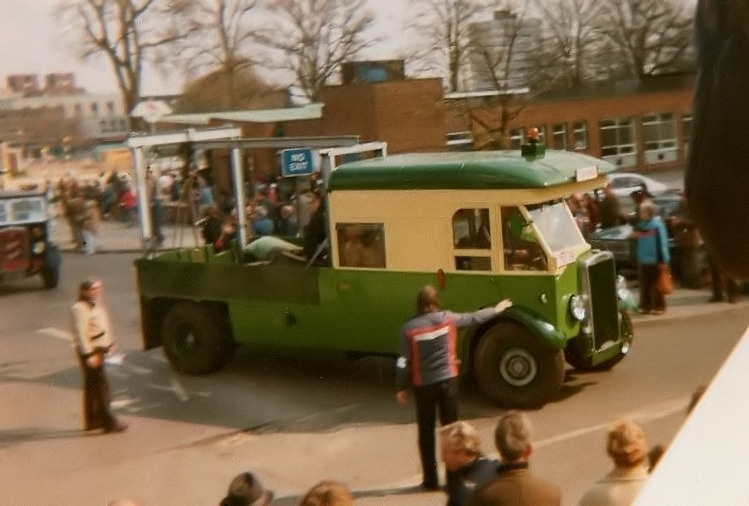
0181 on the London-Brighton run.
"Approaching the ramp at Fishbourne Peter said, "How the hell we going to get up the ramp with this lot?" As ever, the pessimist. I spoke to a couple of the deck hands and said to them that we would need a run at it. Not a problem, was the reply, but we would have to watch the clearance again. Once we docked, the whole lot was backed down to the back of the ferry and once extra wood ramps were in place, off we went. But the wood would not stay in place so we ground to a halt. Don't worry, the lads said, do it again in first gear and we'll hold them in place. It worked and 0182 growled up the ramp bringing 196 safely with her."
"An interesting approach to the railway centre down narrow lanes with hedges brushing on both sides was hairy, especially with 4x4s coming head-on and expecting us to back up! Returning back to the mainland it was uneventful, except a quick visit to Hilsea garage brought some smiles to some of the old hands."
"A postscript to this story. Years later I was asked to tow it to Eastbourne for secure storage under cover and for some reason 0181 was not available. I approached John Jerome, as he was an ex Southdown driver who was driving the coach that broke down at Cuckfield. This was the demise of Betsy as the Freshfield Road fitter took the first left instead of the second left out of Cuckfield. Regrettably this was the time that we lost the last 300 series PD1 that was bought for preservation, by parking it and others to be vandalised in a location near to his home in Hove."
In 1972 Clifford moved to Farnham, Surrey and got involved with Tillingbourne Bus Co. Other part time or casual work was undertaken with Farnham Coaches (he lived behind their yard in Wrecclesham), Warner's Coaches, Milford, and Blue Saloon Bus and Coach Co, Guildford, who bought Warners.
"The Brighton and Hove breakdown tender had been acquired and, although it was in the middle of restoration with panels missing, it was driveable - just! Peter towed it with me in attendance with my trade plates. Whatever happened to that vehicle? I presume 196 is still in storage."
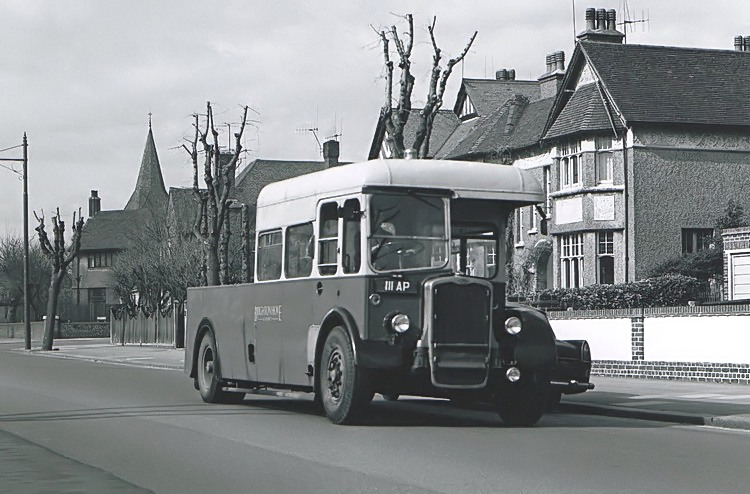
The Brighton Hove and District breakdown tender during its in-service days. Photo by kind permission from Peter Hirst of Mineral Craft North Ltd.
"The funds that were created from the sale of 196 (EUF 196) were utilised in a departure from the usual Southdown vehicle. An enthusiast who happened to be a senior manager at London and Country South H.Q. at Reigate rang me up one day and said, "How would you like an RF that is the first 30 footer that London Transport had?" It turned out to be RF26 and could be seen stored at Dorking garage, so Peter and I went down there to see it. We did not realise that it had been cannibalised to the extent that it had no engine, no conductor's seat, some side lights and head lights and missing seat cushions and frames."
"We decided that it was worth it and then the fun started, after tendering a price that we had been advised would secure the sale. The engine was the first priority, so off to Blue Saloon we went as there were two NLE's in the yard and we knew one had an engine in it. Yes it did, but no heads on it! A call to Alan at Cobham Bus Museum produced a promise of two serviceable heads and the rest was procured from any London and Country garages that would be sympathetic to our cause."
"The engine was picked up by 0181 and transported to my garage at Farnham, and we heaved a sigh of relief when, with friendly help from a crowbar, the engine turned over despite the rust glaze on the bores. The next weekend Alan brought the heads down from Cobham and brokered the deal to let me buy 248 (GCD 48) at an affordable price, as they had had a good return on it with driver training, as related earlier."
"The engine was then assembled and checked for any missing bits and made ready for installation. A friendly fitter at Dorking garage offered to help install it and bring with him the bicycle chain which was the proper winch used to install an RF engine. The great day came and Peter agreed that we would take the engine and all the necessary bits down to Dorking garage and tow RF26 up to my place of work to install the engine there."
"The odd problem was that we didn't have a straight tow bar that normally coupled to a screw-in ring, but one appeared from somewhere so off we went. It took us about 30 minutes to hook up and take the brakes off, then steadily tow it a half a mile to Dorking town station and into an over-roof section between the two factories. The engine was dropped onto a pallet and placed under the bus. Within minutes it had been hoisted in position and we set to with all the connections, including a set of batteries."
"Peter told me to start it, so into the cab I climbed and hung onto the London Transport coat hook that was the starter switch on all L. T. buses of that era. Over and over she went, after we had bled it to death! Puff, puff went smoke out of the exhaust and suddenly she fired, and away the engine went with, at first, a great cloud of smoke from mostly unburnt fuel. Then I decided it was time for the real test."
"I took my foot off the throttle and the engine, which is an AEC laid on its side with a dry sump, ticked over as if she had just arrived off the 725 Green Line route. We cleared all our gubbins and set off in RF26 back to the London and Country garage in Dorking for what was our excuse for a top up with water. The first thing we were asked was, "What happened to the one you towed out of here?" We chuckled and said, this is it!"
"It was an unceremonious journey to Ewhurst where we had to keep her overnight, but she purred along and we put her to bed and congratulated ourselves. We had got another disposed vehicle up and running and the feeling was one of triumph, without a big group of us - just Peter and me and possibly a couple of others from time to time. Peter literally tidied up the NBC paintwork and we rallied her until he got fed up with the livery. So he painted her back into a modified Green Line livery, as she had the double headlights etc."
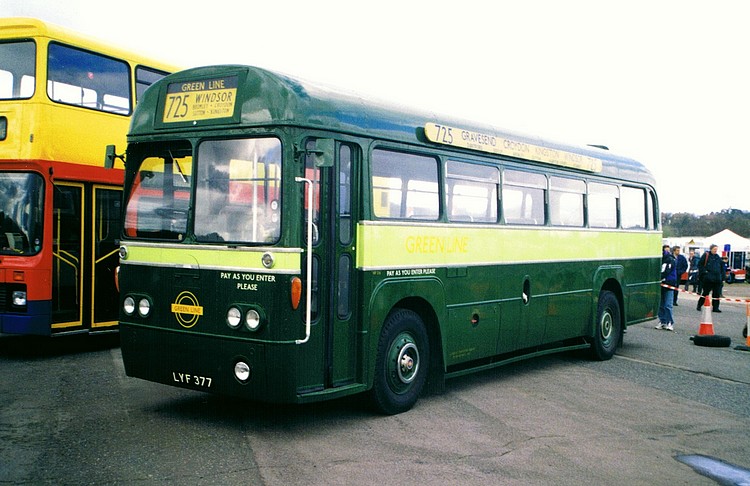
RF26 at the 1998 Cobham rally, after repainting into Green Line colours by Peter Burton. (Photo: Dick Gilbert)
"RF26 gave us a lot of fun, especially when I picked Peter up in it at the Elephant and Castle, where he worked in the London College of Printing as a lecturer. We drove up to some of the north London and Country garages who had promised us some parts e.g. seats which would not fit into a car. With only one exception the greetings were very warm and we and the RF were invited in for a brew. We were always in overalls which appealed to the engineering staff and this helped us melt into the background."
"Finally we headed for home from St Albans loaded with a wealth of spares that had appeared from everywhere, mostly with the help of management who said that it was going to a good cause - keeping the vehicle going. I had a thought sometime after we came back, and asked Peter if I could use RF26 to transport some Majorettes around to shows etc. In exchange for this their treasurer, who was a coachbuilder, would do some work on D689. Peter agreed but did not anticipate the miles I would clock up on it!"
"A couple of memorable events started with the Lord Mayor's Parade at Oxford. I duly arrived with RF26 at Basingstoke on the appointed morning, and took on board the majorettes and their organisers. The journey was quite uneventful until we were bowling along the A34 between nowhere and Newbury. As would be my normal habit driving coaches, I glanced into the interior mirror and couldn't believe my eyes. There were a number of teenage girls getting changed into their majorette costumes and some of them were standing there totally unabashed in their underwear. That memory stuck in my mind even after I got to know them very well as a group travelling to various parts of the country on all sorts of occasions."
"I took to driving the RF in a very relaxed way as the pre-select gearshift and so-called clutch (called the operating pedal) made driving RFs and RTs an absolute doddle. The Lord Mayor's show proved to be another little surprise when the organisers and the majorettes insisted I follow them in the RF throughout the parade. Nothing could be easier with the bus in first gear on tickover, keeping control at walking pace with gentle pressure on the air brakes."
"One other memorable trip was somewhere in deepest Wales in the back of beyond, when Peter wanted to take his own bus somewhere else, so I borrowed one of those famous six-wheel Bedford VALs, best known in the film, The Italian job. We were making progress along the M4 at a 50-60 mph when the oil light came on, however I noticed that, if I backed off the throttle, it went out. Bearing that in mind, we arrived at our destination in one piece and I phoned Blue Saloon to ask them why the oil light came on in these circumstances. Their reply was, oh don't worry, she's not designed to travel more than 50mph, so just take it easy."
"This was not the end as, just prior to heading for home, I was taken seriously ill with food poisoning but, to my relief, one of the Welsh organisers came forward and said he was a bus driver and would drive it back to Basingstoke for me. I believed at the time that he had some form of rail pass so getting back home afterwards was not a problem. I lay on the back seat all the way home and found out how much I was appreciated, as I had three teenage Florence Nightingales watching over me."
"I recovered enough to get the bus back to Blue Saloon from Basingstoke; however it did not deter me from doing part-time driving whenever I was asked, as the arrangement became reciprocal when I needed to use their equipment or workshop."
"Another memory is towing a Leyland TS7 or TS8 which was a coach converted into a salt/gritter for Blackpool Tramways from Blackpool to Kent, followed by Southdown DUF 179 driven by the owner, Les Burchell, who was also owner of Reigate Coaches. All done at 28 m.p.h.! I had just put an engine in it at Blue Saloon Buses at Guildford when Les asked me to do it."
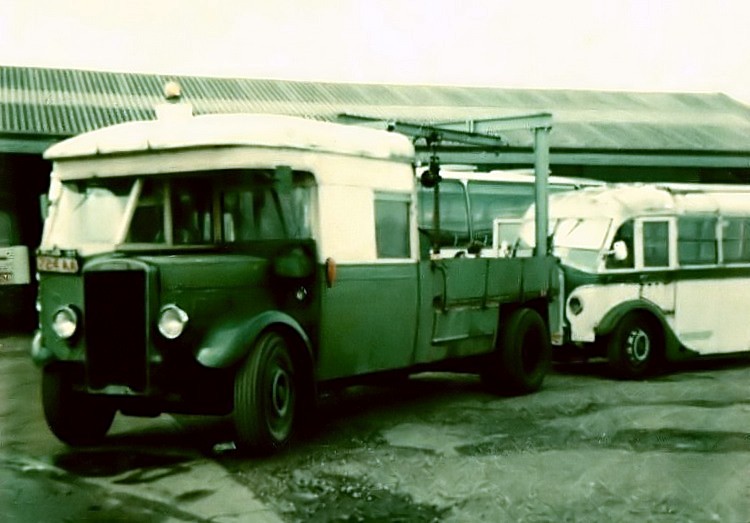
0181 towing the Blackpool gritter.
The picture above shows 0181 when just arrived at Blue Saloon Buses yard in Guildford for refuelling on the second leg of our journey to Staplehurst, home of Michael Banfield, ex-chairman of the H.C.V.S., with the Blackpool gritter on tow and Southdown Tiger DUF 179. This was just before we went along the old A25 up the steep hill onto the top of the North Downs to Newlands Corner which was a 1:6 hill. 0181, by the way was called Betsy.
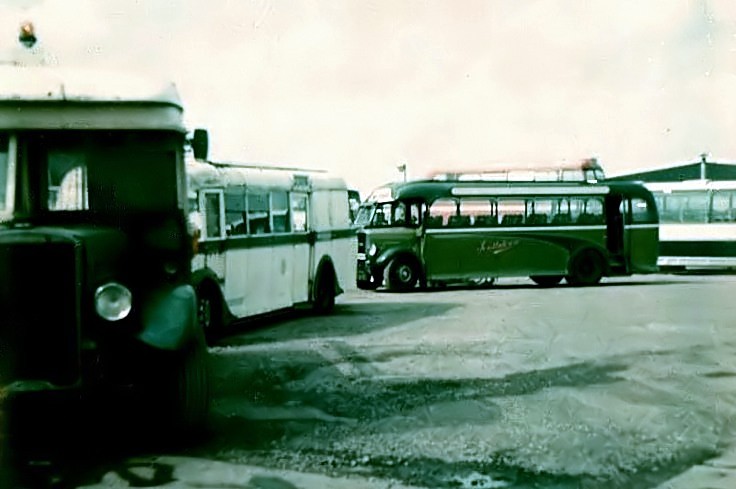
0181 towing the Blackpool gritter with DUF 179 behind.
"At the A25 on the way up to Newlands Corner we just got around the first bend and I had to get her into 1st gear. It went in okay but we had virtually come to a dead stand; she shook and took off settling down to half throttle and, with the usual TD roar, plodded up the hill. A bit later she started to boil so I reached out through the sliding window and loosened the radiator cap. She dribbled water all the way up to the top before I gave her a well-earned rest. She had a cracked block which to this day I don't think has ever been fixed. After a short pause with the engine ticking over we set off down the hill while she cooled off completely."
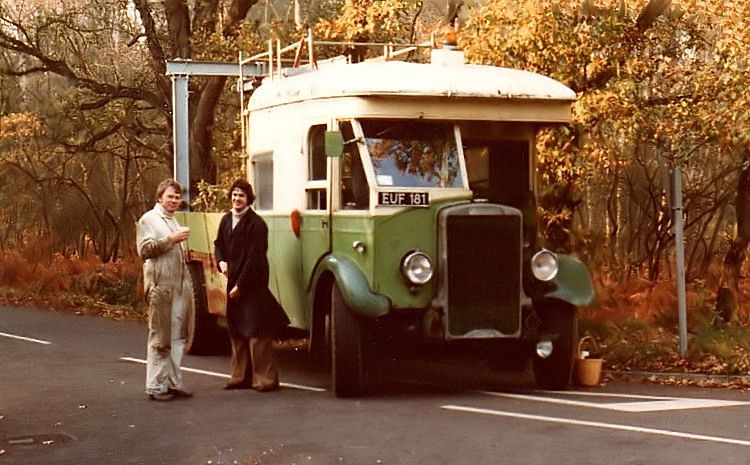
0181 tree cutting in Surrey.
"Now to the tree lopping for Gordon Vane-Hunt. An odd situation arose while acquiring some Brighton Corporation PDs. The purpose was to part-exchange them with a farmer called Lowe for fruit pickers in Kent, and take in two top-box London RTs. Gordon was concerned that his elderly lowbridge Bristol double decker was getting tired and was about to cost a lot of money so I bid for 5010 CD on his behalf which he acquired for his convent school route. He then realised that it was highbridge, so his route - particularly between Hindhead and Farnham - needed cutting."
"Betsy is very scruffy, as I had just put an engine in it and done a tow from Blackpool for Les Burchell."
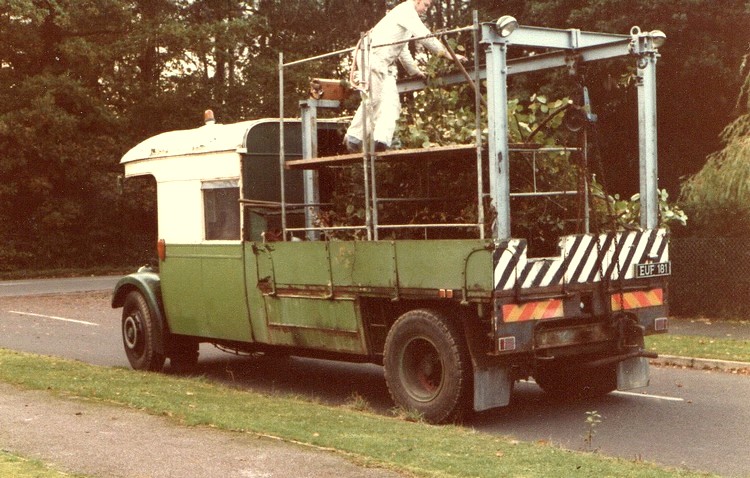
0181 tree cutting in Surrey.
"I recruited a neighbour of mine to help while his wife took photographs and kept us topped up with tea. These pictures show a scruffy 0181 as coming out service with her original number plates back on until I got trade plates. It's by Frensham Pond. Note the black and white stripes which never were replaced, and the cut-out in the rear drop-board for getting the tow bar out, which those days was a straight pole. I went for reusing the swan-neck recovered from supporting the gantry so she could do suspended tow with chain hoists and an A-frame which did not come with it."
"I have to confess that I painted the easy bits of 0181 but I have to thank Peter Burton for the great finish he achieved - and which he had also achieved on 0182 in a coal yard, and RF26 which he bought from the proceeds of selling 196 (EUF 196)."
Continued in Clifford Jones's scrapbook - part two
For more Southdown buses see the Southdown Leyland Tigers - pre-war coaches, the Southdown Leyland Tigers - pre-war buses, the Guy Arab utility buses, the Southdown Leyland Tigers - all post-war vehicles, and the Southdown coaches 1951-1961.
For many other buses, have a look at all the other profiles on the Classic Buses menu page.
SOME LINKS WITHIN THIS WEBSITE: Home Email Links THE COMPLETE WEBSITE MENU Events Diary Halfcab list Small-Ads Classic Irish Buses Classic Manx Buses